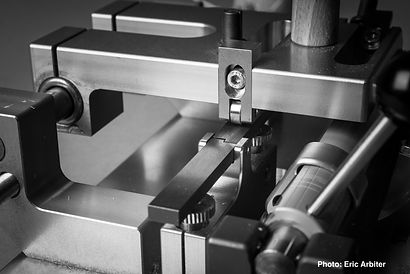What do I charge for machine servicing?
- ericarbiter
- Nov 14, 2023
- 3 min read
I recently saw a question online on the Facebook Double Reed Market Place asking what my charges are for bassoon reed machine service.

My assistant, Ollie, (Clawed DePussy)— "helping" me restore a Pfeifer single profiler
My answer is:
1) Some machines are easier to troubleshoot than others based on their inherent design. For example, Pfeifer single profilers require taking apart the template and adding or subtracting shims. The Pfeifer double profilers are even more complicated due to the second barrel with the template; there are four places to add or subtract shims. There are many more adjustments on that machine than the Pfeifer single machine. I service many Pfeifer profilers. There are a lot of them still around. They are well thought out and designed, though the machining is from a different time.
Typically the modern German machines don’t require taking the machine apart to change the profile settings and there is an evolution in design where setting the profile and also resetting the blades are specified and easier to do. The MD profiler also has an easier system of setting the profile than the Pfeifer machines. There are easier and more precise ways to change the profile without disassembling the machine.
So in other words, some machines require a lot more work to bring back into adjustment than others. After cleaning, oiling, blade sharpening and resetting the blade, the time requited to fully adjust a machine to the client's dimensions varies depending on the make of machine and the condition I find it in.
First and foremost, any machine’s performance depends on the blade’s condition. This is the first factor that has to be right before any further adjustments can productively take place. This all takes time and cane— some machines are just easier to service than others.
2) Depending on how far the adjustments have been moved (often to compensate for blade wear), it will take additional time to return the machine to the settings each bassoonist requests. If the machine’s settings are changed to compensate for a worn blade, then it takes more time to reset the machine than if the condition of the blade is attended to first — that is when it’s no longer cutting well.
As an example, my Pfeifer single has the same number of shims under the pattern since 1975 when I bought the machine. I would sharpen the blade as soon as I noticed it wasn’t cutting well and my profile seemed to be heavier than usual.
The principle is: sharpen the blade; don’t change the settings (if you are satisfied with the profile when the blade was sharp).
My basic estimate usually is around two hours of work. That includes cleaning, lubrication, blade restoration and resetting the machine. If I find the state of the machine warrants more than 2 hours then I charge for each additional hour (or part thereof) at $70 per hour.
As many machines as I see for servicing each year I am impressed by the designs of each brand. A lot of thought has gone into these machines and there has been a lot of evolution in their designs since I was a student in the 60s and 70s.
In some sense, it's hard to imagine how much more difficult our teacher's lives were without these modern machines. On the other hand, with less sophisticated machinery they relied on their hand-craft and the direct engagement with the cane; many of them sounded glorious in spite of the more simple machines and tools at their disposal.
If you have additional questions you can contact me through this website.





Comments